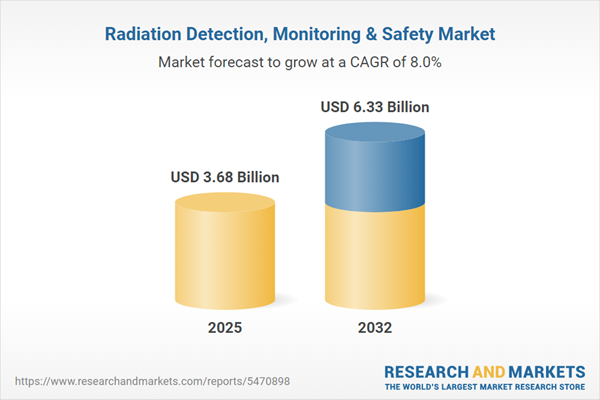Speak directly to the analyst to clarify any post sales queries you may have.
The global market for radiation detection, monitoring, and safety is undergoing rapid transformation, propelled by advances in digital technologies and evolving compliance demands. Senior decision-makers must navigate an increasingly complex landscape where resilience, regulatory alignment, and strategic investment are paramount for operational continuity and competitive edge.
Market Snapshot: Radiation Detection, Monitoring & Safety Market
The Radiation Detection, Monitoring & Safety Market grew from USD 3.41 billion in 2024 to USD 3.68 billion in 2025. It is expected to continue expanding at a CAGR of 8.02%, reaching USD 6.33 billion by 2032. This growth reflects strong adoption across sectors such as healthcare, energy, homeland defense, and industrial settings. The expanding reach of digital and sensor technologies is facilitating more accurate, scalable, and efficient solutions, while organizations worldwide confront shifting economic and regulatory pressures.
Scope & Segmentation
This report offers an in-depth analysis of the landscape, focusing on the principal market drivers, product innovation, and regional dynamics within the radiation detection, monitoring, and safety market. The segmentation covers industry needs and evolving compliance standards, ensuring relevance for procurement, operations, and innovation leaders.
- Product Types: Radiation detection and monitoring equipment such as area monitoring systems, dosimeters, and material monitors, alongside safety equipment including eyewear, face shields, gloves, and specialized footwear.
- Detection Types: Systems designed for alpha, beta, and gamma radiation, tailored to meet specific requirements for sensitivity and application.
- Technologies: Portable and stationary solutions that provide flexible and continuous coverage across diverse operational contexts.
- Technology Types: Analog detection for cost-sensitive or basic applications and digital detection platforms leveraging advanced analytics and remote diagnostics.
- Composition Options: Gas-filled detectors, scintillators, and solid-state detectors, each offering a balance of accuracy, durability, and maintenance.
- Applications: Utilizations in environmental monitoring (air, soil, water), homeland security and defense (border security, cargo scanning), industrial inspection (electronic components, pipeline), medical imaging, and academic research.
- Sales Channels: Both offline and online pathways, including brand websites and third-party e-commerce platforms.
- Regional Markets: Comprehensive coverage of the Americas, Europe, the Middle East, Africa, and Asia-Pacific, with tailored analysis for each sub-region and country.
- Leading Companies: Profiles and strategies of key industry players, from instrumentation specialists to multinational conglomerates, showcasing leadership in innovation and compliance expertise.
Key Takeaways for Senior Decision-Makers
- Organizations are shifting from isolated, standalone devices toward integrated monitoring ecosystems, utilizing IoT connectivity and cloud-based analytics for real-time risk management.
- Regulatory shifts and evolving international standards are raising the bar for quality assurance, driving tighter alignment with global and regional compliance frameworks.
- End-user demands for portable, fast-deploy solutions are escalating, particularly in critical sectors including disaster response and border security.
- Technology partnerships between manufacturers and regulators are accelerating the pace of innovation and reducing time to market for next-generation solutions.
- Service-centric models that bundle equipment with maintenance and software support are emerging as preferred procurement options, providing predictable costs and ongoing performance guarantees.
- Regional diversity in regulatory approaches and economic conditions requires adaptive go-to-market strategies for sustaining growth and ensuring compliance.
Tariff Impact on Supply Chains
Recent United States tariffs on imported radiation safety equipment have caused supply chain recalibrations, prompting a shift toward domestic sourcing and accelerated collaboration on alternative materials. These tariffs introduced new cost constraints and encouraged organizations to extend the lifecycle of existing assets through upgrades instead of full replacements. The resultant ecosystem has become more diversified, with a heightened focus on resilient procurement strategies and regional supplier engagement.
Methodology & Data Sources
This report is founded on a rigorous multi-step methodology, combining comprehensive secondary research with expert interviews across the supply chain. Validation through data triangulation and stakeholder workshops ensures depth and accuracy, while peer reviews and scenario analysis uphold methodological integrity in identifying market trends and opportunities.
Why This Report Matters
- Supports strategic planning by providing a detailed, application-driven market breakdown across technology, product, and regional segments.
- Enables procurement and operational leaders to assess best-fit solutions, supplier capabilities, and evolving compliance landscapes for informed decision-making.
- Equips executives with actionable insights on market trends, tariff impacts, and emerging partnership models to enhance resilience and growth agility.
Conclusion
This report empowers organizations to navigate the shifting landscape of radiation detection, monitoring, and safety with strategic clarity. Informed choices across technology, operations, and market approach will drive sustainability, regulatory alignment, and operational excellence for years ahead.
Additional Product Information:
- Purchase of this report includes 1 year online access with quarterly updates.
- This report can be updated on request. Please contact our Customer Experience team using the Ask a Question widget on our website.
Table of Contents
3. Executive Summary
4. Market Overview
7. Cumulative Impact of Artificial Intelligence 2025
Companies Mentioned
The companies profiled in this Radiation Detection, Monitoring & Safety market report include:- AMETEK, Inc.
- Berthold Technologies GmbH & Co. KG
- Bertin Technologies SAS
- Bruker Corporation
- Cobham Limited
- Cole-Parmer Instrument Company, LLC
- ECOTEST Group
- Exosens
- Fluke Corporation
- Fuji Electric Co. Ltd.
- General Electric Company
- Hamamatsu Photonics K.K.
- Kromek Group PLC
- Landauer, Inc.
- LAURUS Systems
- Leonardo DRS, Inc.
- LND, Inc.
- Ludlum Measurements, Inc.
- Malvern Panalytical Ltd.
- Mirion Technologies, Inc.
- Oxford Instruments plc
- PCE Instruments UK Ltd.
- Scionix Holland B.V.
- SciWise Solutions Inc.
- Symetrica Inc.
- Teledyne Technologies, Inc.
Table Information
| Report Attribute | Details |
|---|---|
| No. of Pages | 186 |
| Published | November 2025 |
| Forecast Period | 2025 - 2032 |
| Estimated Market Value ( USD | $ 3.68 Billion |
| Forecasted Market Value ( USD | $ 6.33 Billion |
| Compound Annual Growth Rate | 8.0% |
| Regions Covered | Global |
| No. of Companies Mentioned | 27 |









